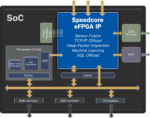You are currently viewing SemiWiki as a guest which gives you limited access to the site. To view blog comments and experience other SemiWiki features you must be a registered member. Registration is fast, simple, and absolutely free so please,
join our community today!
When designing IP for system-on-chip (SoC) and application-specific integrated circuit (ASIC) implementations, IP designers strive for perfection. Optimal engineering often yields the smallest die area, thereby reducing both cost and power consumption while maximizing performance.
Similarly, when incorporating embedded… Read More
The rapid technological evolution and soaring mask set costs have created numerous challenges for designers today. Protocols, algorithms, and cryptography are all advancing at a blistering pace, leaving designers struggling to keep up. While fab suppliers are enhancing performance and reducing power consumption, this … Read More
Field-Programmable Gate Arrays (FPGAs) have long been celebrated for their unmatched flexibility and programmability compared to Application-Specific Integrated Circuits (ASICs). And the introduction of Embedded FPGAs (eFPGAs) took these advantages to new heights. eFPGAs offer on-the-fly reconfiguration capabilities,… Read More
In the dynamic landscape of chip design, two trends stand out as game-changers: the rise of the RISC-V instruction set architecture (ISA) and the advent of Software Defined products. Today, we delve into why these trends are not just shaping the industry but propelling companies like Andes and Menta to the forefront of innovation.… Read More
RISC-V have great adoption and momentum. One of the key benefits of RISC-V is the ability for SoC designers to extend its instruction sets to accelerate specific algorithms. Andes’ ACE (Andes Custom Extensions) allow customers to quickly create, prototype, validate and ultimately implement custom memories, dedicated ports… Read More
With our continuing chiplet coverage I found this of great interest. I have always felt that eFPGAs and chiplets are a natural fit for the next generation of chip design and this is an excellent example. As we design with chiplets one of the challenges is verification/validation in regards to performance and interoperability. … Read More
The emergence of chiplets as a technology is an inflection point in the semiconductor industry. The potential benefits of adopting a chiplets-based approach to implementing electronic systems are not a debate. Chiplets, which are smaller, pre-manufactured components can be combined to create larger systems, offering benefits… Read More
When you think “FPGA,” what comes to mind? Massive, expensive parts capable of holding a lot of logic but also consuming a lot of power. Reconfigurable platforms that can swallow RTL for an SoC design in pre-silicon testing. Big splashy corporate acquisitions where investors made tons of money. Exotic 3D packaging and advanced… Read More
Dan is joined by Nick Ilyadis, Senior Director of Product Planning at Achronix. With over 35 years of data and semiconductor engineering and manufacturing experience and 72 issued patents under his name, Nick is a recognized expert on software and hardware development and quality control.
Dan explores the emerging chiplet market… Read More
We have written about eFPGA and for six years now and security even longer so it is natural to combine these two very important topics. Last month we covered the partnership between Flex Logix and Intrinsic ID, and the related white paper. Both companies are SemiWiki partners, so we were able to provide more depth and color:
In the … Read More








